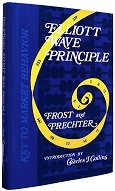The Elliott Wave Principle
The
Elliott
Wave Principle was published in the 1970s by Frost and
Prechter but The Wave
Principle was originally developed in the 1930s
by Ralph Nelson Elliott who had the view that
'Because,
man is subject to rhythmical procedure, calculations having to do with
his activities can be projected far into the future with a
justification and certainty heretofore unattainable.'
A respected accountant, RN Elliott suffered from periods of
ill
health and at a time of historical stock market activity, spent much of
his time studying the movements of the financial markets to occupy his
mind.
He observed that the markets often appeared to move in repetitive and
recognisable patterns.
Elliott
Wave Principle, Now Available Free
Robert
Prechter has just released a complimentary online edition of Elliott
Wave Principle: Key to Market Behavior. All 248-pages of this classic
investment book can be on your screen in just minutes.
Elliott Wave Principle will teach you the 13 waves that can occur in
the charts of the financial markets, the basics of counting waves, and
the simple rules and guidelines that will help you to apply EW for
yourself. You'll learn the method of analysis that successful
investors have
been using for decades.
R.N.
Elliott studied the
charts of a number of stock market indexes spanning 75 years
at various
degrees of time, from Yearly down to 30 mins. What he discovered was
that these patterns were repetitive and took the form of interlinking waves.
These waves then went on to develop into larger waves within
similar patterns. Elliott noted that'What appears random
and
unrelated, will actually trace out a recognizable pattern
once
you learn what to look for.'
What Elliott
then set out to describe using the Elliott Wave theory was how the
market
actually behaves. There are a number of specific
variations on the
underlying pattern, which Elliott meticulously described and
illustrated.
He also noted the important fact that each pattern has
identifiable requirements as
well
as tendencies.
From these observations, he was able to formulate numerous rules and
guidelines for 
correct wave identification. A thorough knowledge of such
details is necessary to understand
what the markets can do, and at
least as important, what
it does not do.
Elliott's
work remained relatively unknown until the 1970s when A.J. Frost and
Robert
Prechter Jr. published the Elliott
Wave Principle which is now
widely regarded as the
definitive guide to Elliott Waves.
It has
since become one of the most popular and commonly used financial
technical analysis indicators used today.

This technical analysis
best seller
from Frost and Robert Prechter is essential
reading for anyone who is serious about using technical analysis of
the financial markets. It is the wavers
guide book,' and it may well turn
out be the best $29 you ever spent. One good trade on the back of it is
going to net you a lot more than that so we think it is a very good
investment to have a
copy.
Get
The Elliott Wave Principle
direct from Elliott
Wave International to
ensure you get the
latest edition of Robert Prechters Best Seller.
The
Elliott Wave Principle
Following
the publication of the Elliott
Wave Principle, Robert
Prechter Jr. then went on to create the world's largest
stock market
forecasting service, Elliott
Wave International (EWI).
EWI's team of analysts provide forecasts for every major
market in the world and through their free to join, Club EWI
membership, offer an impressive range of very good quality educational
materials such as tutorials, videos, special reports, webinars...etc.
EWI,
have
an extremely useful
EW
tutorial available for free online.
It's
broken up into 10
lessons
across 50 pages, so it's easy to read and review at your
leisure. These lessons cover the subject in more detail Learn
more about the Elliott
Wave Principle and how to access the free
Tutorials.
|